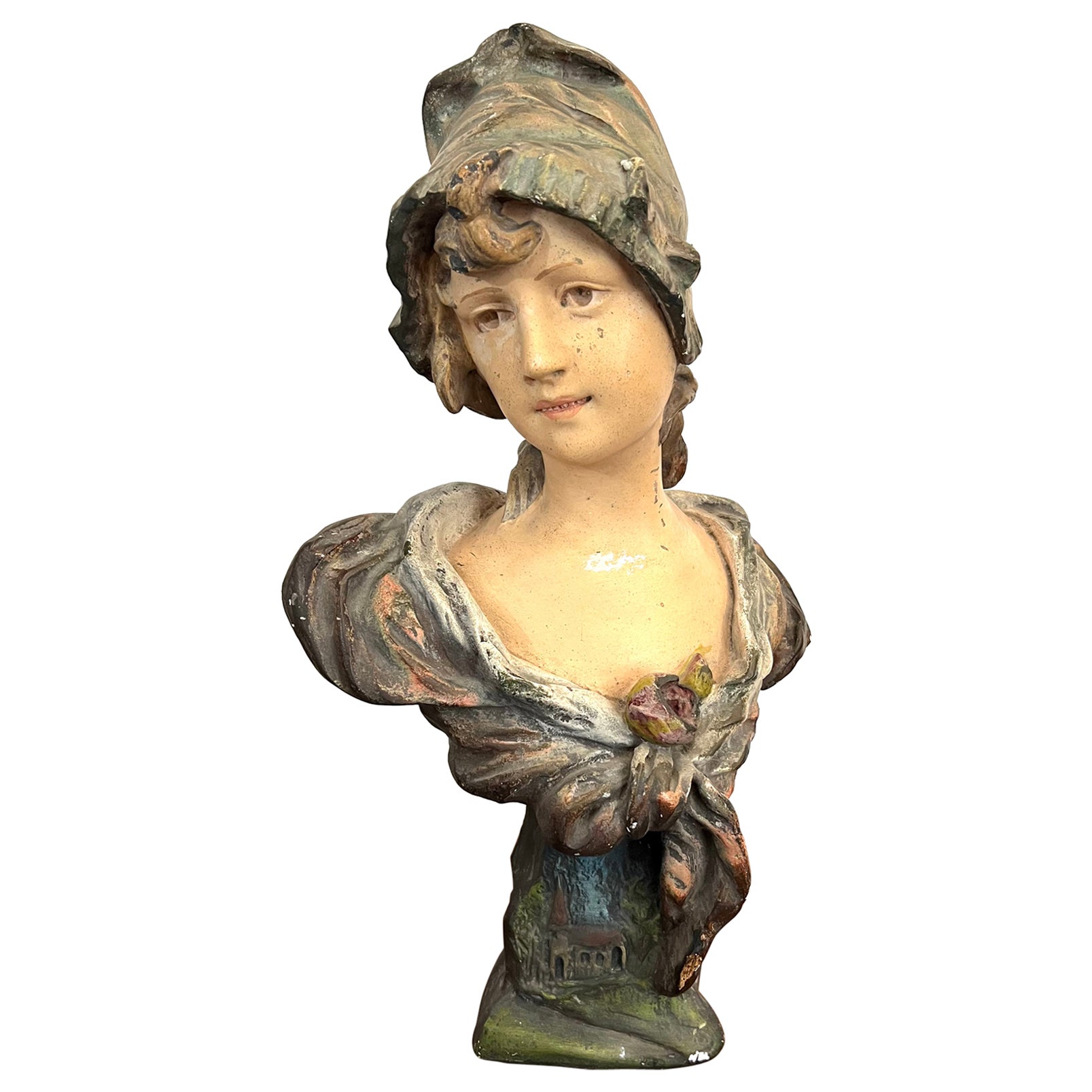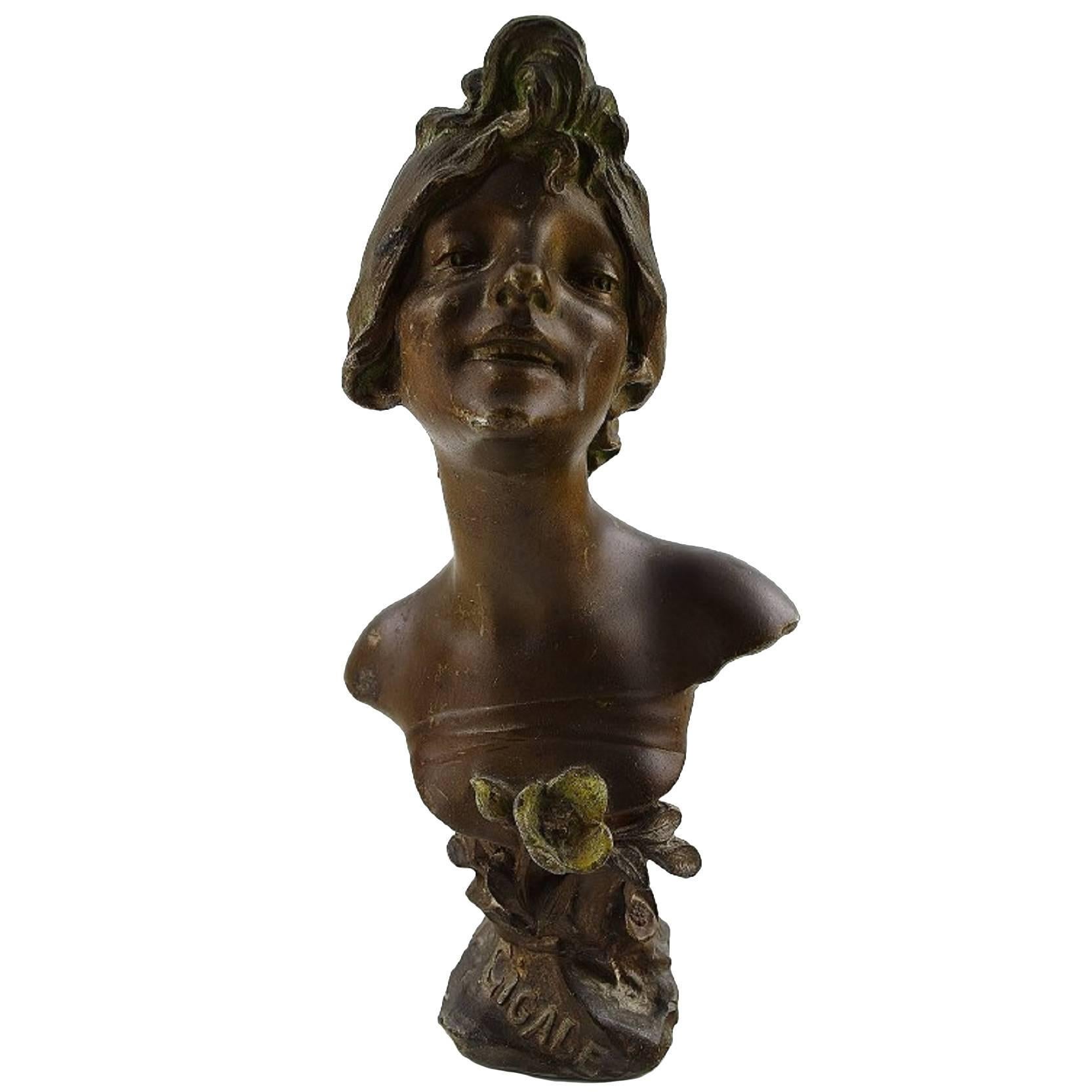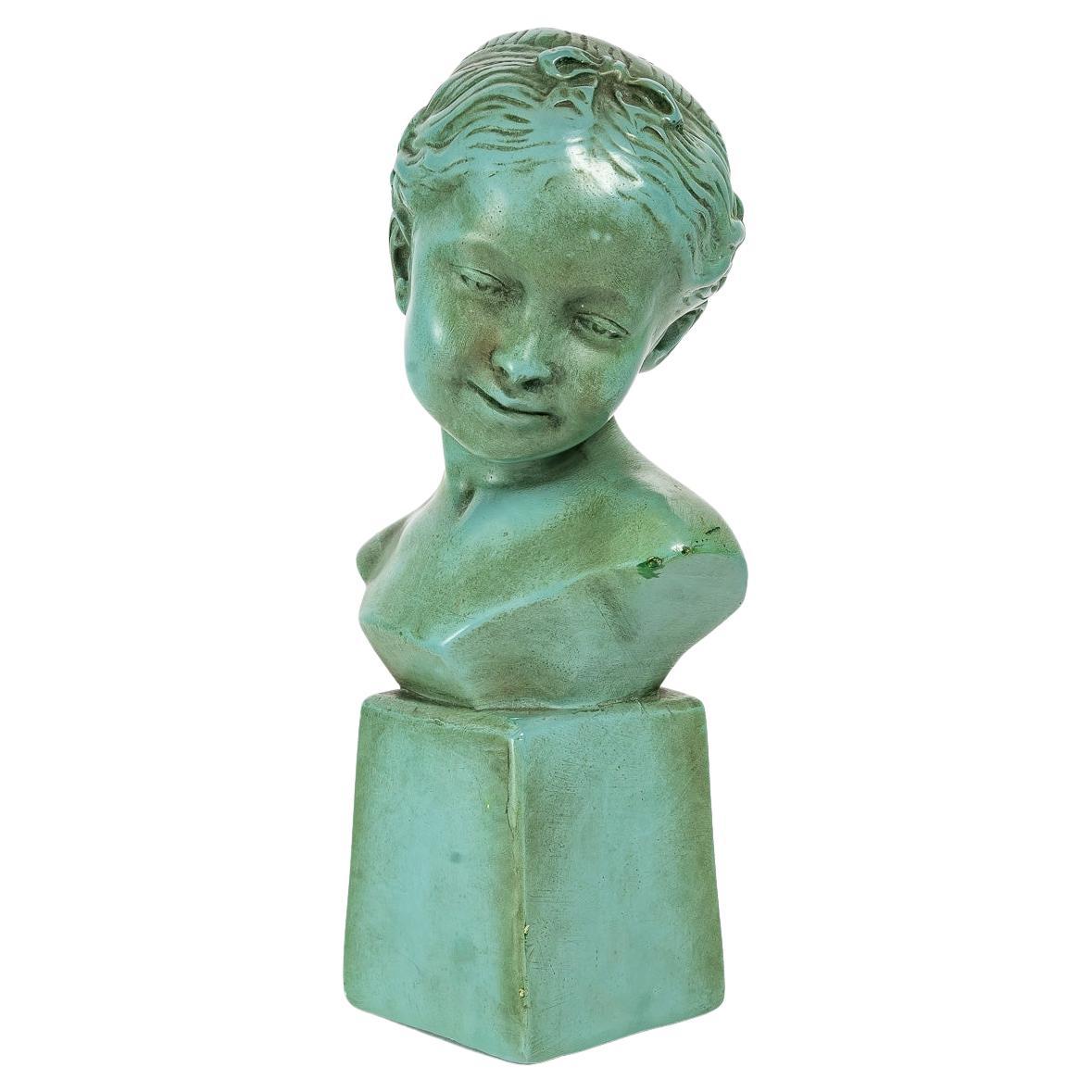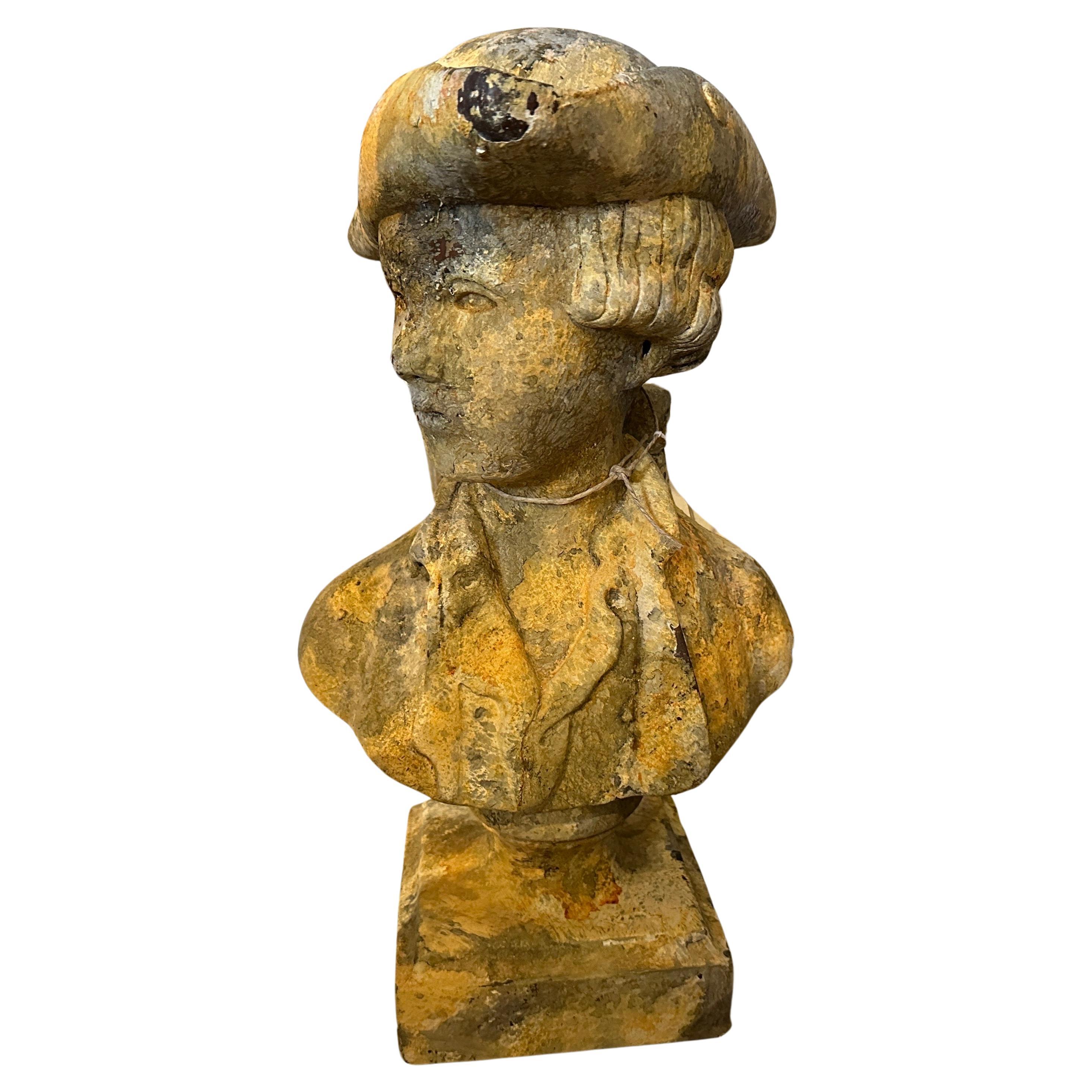Items Similar to French Art Nouveau Wax Young Girl Bust Sculpture, ca.1900
Want more images or videos?
Request additional images or videos from the seller
1 of 12
French Art Nouveau Wax Young Girl Bust Sculpture, ca.1900
About the Item
Wax young girl bust sculpture by Mme Arondelle, 2 rue du Louvre, Paris, France, ca.1900. Polychrome wax. After the famous Wax Head from the Lille museum (France). Height : 17.9"(45.4cm), Width : 13.2"(33.5cm), Depth : 8.7"(22cm). Marked on the back "Mme ARRONDELLE Editeur propiétaire No2 rue du Louvre Paris". Brass plate "Collection particulière ARRONDELLE 2 rue du Louvre Paris".
The Wax Head, or Wicar Head, is a lightly polychromed wax bust of a woman wearing a terracotta drapery which was bequeathed by Jean-Baptiste Wicar to the Society of Sciences, Agriculture and Arts of Lille in 1834 Considered a masterpiece, it made the Lille museum famous until the middle of the 20th century.
The Wax Head is part of the bequest of Jean-Baptiste Wicar to the Society of Sciences, Agriculture and Arts of Lille, in 1834. In the report of deposit of the bequest, it is designated as “A head in wax, from the time of Raphael”, without further details.
While the legacy apparently pays little attention to it, the Wax Head is immediately and unanimously considered a masterpiece. This is how it is described in the Catalog of drawings and art objects bequeathed by Wicar established by the Society of Sciences, Agriculture and Arts in 1856. Its attribution to Raphael, by a shortcut that the designation of the bust in the legacy did not authorize, however, is quickly called into question. In the notice of the 1856 catalog, Charles Benvignat first suggests distinguishing the wax work from the drapery and the terracotta pedestal which dates from the 18th century. He then suggests an ancient origin, based on the discovery in 1853 of wax heads in Roman tombs from the time of Diocletian in Cumae.
A few years later, Jules Renouvier also rejected the attribution to Raphael but suggested seeing in the bust of a young girl the work of Orsino Benintendi, a 15th century Florentine wax artist, under the direction of Andrea del Verrocchio, the master of Leonardo da Vinci. In 1878, Louis Gonse, who opened his remarks with a parallel with the Mona Lisa, agreed with his opinion in a long article which refuted the previous attributions.
For Louis Courajod, who established a correspondence with a drawing of a young girl's head separated from the body attributed to Raphael and kept at the Albertine library in Vienna, the wax head is a cast taken from the corpse of a young girl. However, he does not comment on the author, and seems to agree with the opinion of Jules Renouvier and Louis Gonse.
The bust also arouses the admiration and interest of Germanic art historians. Henry Thode, who takes up the correspondence with the drawing of the Albertine of Vienna, formulates the hypothesis that the wax head could be the portrait of a young Roman girl whose perfectly preserved corpse was discovered in 1485 in a tomb of via Appia.
These theses are refuted by Hubert Janitschek, who thinks that the wax head cannot be linked either to antiquity or to the time of Andrea del Verrocchio. He does not give the name of the author but concludes that “like the Mona Lisa, the bust of Lille will also continue to exercise the imagination of poets, who will strive to penetrate its secret; they will be able, in their compositions, to boldly rank it among the most beautiful conquests of modern times; antiquity, we believe we can affirm, is beyond the question here”. Franz Wickhoff, for his part, basically agreeing with Janitschek, considers in an article from 1901 that the wax bust and the terracotta pedestal are contemporary and date from the second half of the 17th century.
Even today, the author of The Wax Head remains unknown. Silvia Urbini observes that the girl's head evokes, both in morphology and in the materials used, the works of the Bolognese sculptor Angelo Piò produced during the first half of the 18th century9. The website of the Association of Museum Curators of Hauts-de-France specifies that “in the current state of research, it is very likely that the work was created by François Duquesnoy, Flemish sculptor, who died in Tuscany in 1643 », but the information sheet for the Palace of Fine Arts remains very cautious and simply mentions: “What we are certain of is the reference to Renaissance Italy, considered by artists as an ideal of perfection. ».
Whatever its origin, its author or its destination, the Wax Head from the Lille museum acquired considerable notoriety during the second half of the 19th century.
This is how in 1869, Alexandre Dumas fils had a copy made by Henry Cros which he placed in his study. About her, he wrote in a letter addressed to a friend: “I would like to show you on a table, near my library, in front of a large silk hanging embroidered with fantastic animals of all colors, a young girl's head in wax , unique copy that I had made, of the one which is at the Lille Museum and which is brought back to Raphaël; I believe it is from Leonardo, but my opinion has no bearing on the matter. This head is divine. Cros copied it with love. It is the great whole in a small volume, because its expression gives the image of life, and the material of which it is made gives the sensation of death. What we have written together over several years is prodigious…”
In 1889, the bust was the subject of a reverie by Paul Bourget during which he imagined the young wax girl as the heroine of Boccaccio in The Decameron or Stendhal in The Abbess of Castro.
In her memoirs, the singer Yvette Guilbert says that she was inspired by the Wax Head from the Lille museum to compose her stage character, “her paleness, her crown of red hair also being my share”. And she adds: “Its distinction, without research, came, in my opinion, from its perfect simplicity. Above all, and above all, I wanted to appear very distinguished, to allow me to dare everything in a repertoire..."
The Wax Head is cited by Jean Lorrain in Monsieur de Phocas and by Marcel Proust in On Reading (it seems, in reality, that he is rather referring to the Unknown Woman today attributed to F. Laurana and kept in Paris at the Louvre Museum), but her notoriety goes beyond borders and she is also the heroine of a short story by the Austrian writer Ossip Schubin, Blanche: the maid of Lille, translated into several languages. As late as 1939, it was the pretext for a novel by Léopold Delannoy, On a Flee la Tête de Cire, subtitled Lille tourist novel.
- Similar to:Studio Art Deco (Designer)
- Dimensions:Height: 17.88 in (45.4 cm)Width: 13.19 in (33.5 cm)Depth: 8.67 in (22 cm)
- Style:Art Nouveau (Of the Period)
- Materials and Techniques:Synthetic
- Place of Origin:
- Period:1900-1909
- Date of Manufacture:ca.1900
- Condition:
- Seller Location:Saint-Amans-des-Cots, FR
- Reference Number:1stDibs: LU2312337582622
About the Seller
5.0
Platinum Seller
These expertly vetted sellers are 1stDibs' most experienced sellers and are rated highest by our customers.
Established in 2003
1stDibs seller since 2016
403 sales on 1stDibs
Typical response time: <1 hour
- ShippingRetrieving quote...Ships From: Saint-Amans-des-Cots, France
- Return PolicyA return for this item may be initiated within 2 days of delivery.
More From This SellerView All
- French Art Nouveau Alabaster Young Lady, 1900By Claire Jeanne Roberte CollinetLocated in Saint-Amans-des-Cots, FRFrench Art Nouveau sculpture, France, ca.1900. Young Lady Bust. Alabaster & marble. In direct carving. Height : 12.2"(31cm), Width : 11.8"(30cm), , Depth : 6.7"(17cm)Category
Antique Early 1900s French Art Nouveau Busts
MaterialsAlabaster, Marble
- SCOLISSE French Art Deco Young Girl & Antelope Sculpture, ca.1930By ScolisseLocated in Saint-Amans-des-Cots, FRFrench Art Deco sculpture by Scolisse, France, ca.1930. Young Girl & Antelope. Spelter, bakelite and marble. Width : 25.6"(65cm), Height : 16.9"(43cm), Depth : 6.8"(17.2cm). Weight :...Category
Vintage 1930s French Art Deco Figurative Sculptures
MaterialsMarble, Spelter
- French Art Deco Young Girl & Dog Sculpture by P.Sega, 1930sBy Studio Art DecoLocated in Saint-Amans-des-Cots, FRFrench Art Deco sculpture by P.Sega, France, 1930s. Young girls " greyhound. Cold painted spelter and marble. Measures: Width : 14.9"(37.9cm), Height : 10.4"(26.5cm), Depth : 4.5"(11...Category
Vintage 1930s French Art Deco Animal Sculptures
MaterialsMarble, Spelter
- French Art Deco Lumberjack Sculpture, Ca.1925By Studio Art DecoLocated in Saint-Amans-des-Cots, FRFrench Art Deco sculpture, France, ca.1925. "Lumberjack". Spelter, marble & onyx. Measures: width : 27.5"(70cm), height : 22"(56cm), depth : 8.8"(22.5cm). Weight : 27.5 kgs. Some bit...Category
Vintage 1920s French Art Deco Figurative Sculptures
MaterialsOnyx, Marble, Spelter
- French Art Deco Young Girl & Partridge Sculpture, 1920sBy Claire ColinetLocated in Saint-Amans-des-Cots, FRFrench Art Deco sculpture, France, 1920s. Young girl & partridge. Spelter, onyx and marble. Width : 22.8"(58cm), Height : 8.3"(21cm), Depth : 4.7"(12cm). Slight traces of age on pati...Category
Vintage 1920s French Art Deco Figurative Sculptures
MaterialsMarble, Onyx, Spelter
- Berthe GIRARDET Old Woman Old Woman Bust Sculpture, ca.1900By Claire Jeanne Roberte CollinetLocated in Saint-Amans-des-Cots, FROld woman terra cotta bust sculpture by Berthe GIRARDET (1861-1948), Manufacture de l'Isle-Adam (north of Paris), France, ca.1900. Polychrome terracotta. Height : 16"(41cm), Width : 18"(46cm), Depth : 9.4"(24cm). Berthe Girardet born in Marseille on April 8, 1861, is the daughter of Charles Gustave Imer (1826-1907), a wealthy merchant of Swiss origin based in Marseille, and of Hélène Rogers, daughter of an American merchant based in Naples. She trained in the workshop of Émile Aldebert and exhibited her first works under her young daughter Berthe Imer until her marriage in 1893 with the painter-engraver Paul-Armand Girardet (1859-1915), descendant of a family of Swiss artists, the Girardets, originally from Le Locle. She is buried in the new cemetery of Neuilly-sur-Seine (Hauts-de-Seine) Artworks Portrait of Paul Girardet at the Neuchâtel museum The fisherman of Tréport The bullfighter The sick...Category
Early 20th Century French Art Nouveau Busts
MaterialsTerracotta
You May Also Like
- Art Nouveau Bust of a Young Lady Sculpture 1900 LatourLocated in Berlin, DE-Art Nouveau bust - Alabasta with marble pedestal - Signed latour - Good conditionCategory
Antique Early 1900s French Art Nouveau Busts
MaterialsAlabaster
- Large sculpture Statue Woman Girl Lady Bust 1900 Art NouveauBy Emmanuel VillanisLocated in LA FERTÉ-SOUS-JOUARRE, FRSuperb and rare polychrome plaster sculpture representing the bust of a young woman wearing a bow dress and a hat. The bust is signed on the side but the signature is difficult to re...Category
Early 20th Century French Art Nouveau Busts
MaterialsPlaster
- Julien Caussé, Art Nouveau Bronze Bust of a Young Beauty, France, circa 1900By Julien CausseLocated in Copenhagen, DKJulien Caussé, a well listed French sculptor. Art Nouveau bronze bust of a young beauty "Cigale". In very good condition, fine patina. France, circa 1900. Stamp: J. Caus...Category
Antique Early 1900s French Art Nouveau Busts
- Lacquered Plaster Sculpture, Bust of a Young GirlLocated in Saint-Ouen, FR"Lacquered plaster sculpture, bust of a Young Girl". Delicate lacquered plaster sculpture representing the bust of a young girl, early 20th century, Art Nouveau. Measures: H: 3...Category
20th Century French Art Nouveau Busts
MaterialsPlaster
- A 1900s Art Nouveau Patinated Wood Italian Bust of a Young BoyLocated in Catania, SiciliaThis Art Nouveau Italian bust embodies the movement's hallmark features and also incorporating elements influenced by Italian art and culture. Their historical and artistic value mak...Category
Early 20th Century Italian Art Nouveau Busts
MaterialsFruitwood
- 1930s Art Nouveau Terracotta Sicilian Sculpture of a Young GirlLocated in Catania, SiciliaA terracotta sculpture hand-crafted in Sicily in the first half of 20th century, it's in original patina with signs of use and age. A terracotta sculpture it's a captivating piece of...Category
Mid-20th Century Sicilian Art Nouveau Busts
MaterialsTerracotta
Recently Viewed
View AllMore Ways To Browse
Art Nouveau Office
Bust Sculpture Lincoln
John Milton Bust
Galatee Sculpture
Small Gaddi Torso Sculpture
Bernini Bust
Alabaster Bust Of Diana The Huntress
Goldscheider Balinese Bust
Bust Of Diana The Huntress
Frilli Antonio
Hermes Plaster Bust
Houdon Brongniart
Louise Brongniart Busts
Ajax Bronze
G Ruggeri
Sebastian Bach
Wedgwood Basalt Bust
Antique Phrenology Bust





